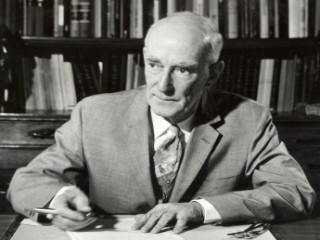
Jan Oort biography
Date of birth : 1900-04-28
Date of death : 1992-11-05
Birthplace : Franeker, Friesland
Nationality : Dutch
Category : Arhitecture and Engineering
Last modified : 2011-07-18
Credited as : Astronomer, radio astronomy pioneer, Bachiene Foundation Prize
Jan Hendrik Oort was born on April 28, 1900, in the farming village of Franeker in Holland. At the age of 17 he entered the University of Groningen and earned his doctoral degree in 1926. He received the Bachiene Foundation Prize (1920), undertook research at the Leiden Observatory (1924), and lived abroad as a research associate at the Yale University Observatory (1924-1926).
In 1926 Oort became an instructor at the University of Leiden, and the following year he married Johanna M. Graadt van Roggen. They had three children, sons Coenraad and Abraham and a daughter, Marijke. Oort became a professor of astronomy (1935) and director of the observatory (1945) at the University of Leiden. In his career he was elected leader of several international astronomical groups. He received numerous awards, including the important Vetlesen Prize in 1966 from Columbia University.
Oort's early studies, under his teacher Jacobus Kapteyn, made him familiar with Kapteyn's celestial model, which placed the sun at the center of a relatively small galaxy. In 1917, however, Harlow Shapley challenged Kapteyn's model, proposing a far bigger one. Oort's first major scientific achievement was to provide observational evidence that confirmed the main features of Shapley's model. Shortly after he joined the Leiden faculty in 1926, Oort found that stars with velocities greater than about 65 kilometers per second move predominantly toward one hemisphere of the night sky. That is consistent with the theory that our solar system rotates around the distant center of our galaxy and that other solar systems move around the same center. It was the first direct evidence of the Milky Way's rotation.
From his observations and calculations, Oort was able to show that our galaxy was much bigger than previously thought and that it contained many more stars. Oort also determined that the sun was not even close to the galaxy's center. "Like a modern Copernicus, Oort showed that our position in nature's grand scheme was not so special," said Seth Shostak, a U.S. astronomer.
After World War II Oort and his associates at Leiden built a huge radio telescope to detect radio waves in hydrogen and made far-reaching discoveries on the evolution and structure of our galaxy. They found evidence that supported the hypothesis that stars are formed out of hydrogen and dust clouds; they proved the spiral structure of our galaxy and found its period of rotation to be over 200 million years; and they located and investigated the processes occurring in the galactic core and the vast corona of hydrogen encircling the galaxy. They also investigated the origin of radio signal sources, including the group of stars known as the Crab Nebula, which they demonstrated to be a remnant of the supernova that appeared in 1054. Oort was credited with promoting radio astronomy in its early years and with putting the Netherlands in the forefront of postwar astronomy.
Oort's observations showed that there is much more mass in the universe than can be detected visually. This was a pioneering recognition of the undetected "missing mass" or "dark matter" that is believed to make up more than 90 percent of the universe.
Oort is best known to casual students of astronomy for his discoveries in what to him was a sideline, the study of comets. By plotting their trajectories, Oort traced comets back to a region on the outskirts of the solar system. He theorized that in the distant past a planet that occupied a position between Mars and Jupiter exploded, sending most of its material into interstellar space, but a small percentage of the material became trapped in a region roughly 4,000 times as far away from our sun as Pluto. Fragments of this material are occasionally pulled by the gravity of the outer planets or a passing star into an orbit around the sun. The region that is the birthplace of comets became known as the Oort Cloud.
















